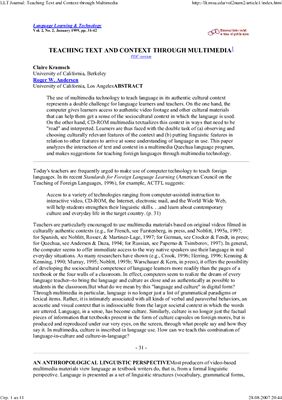Language Leaing & Technology, Vol. 2, No. 2, January 1999, pp.
31-42
The use of multimedia technology to teach language in its authentic cultural context
represents a double challenge for language leaers and teachers. On the one hand, the
computer gives leaers access to authentic video footage and other cultural materials
that can help them get a sense of the sociocultural context in which the language is used.
On the other hand, CD-ROM multimedia textualizes this context in ways that need to be
"read" and interpreted. Leaers are thus faced with the double task of (a) observing and
choosing culturally relevant features of the context and (b) putting linguistic features in
relation to other features to arrive at some understanding of language in use. This paper
analyzes the interaction of text and context in a multimedia Quechua language program,
and makes suggestions for teaching foreign languages through multimedia technology.
The use of multimedia technology to teach language in its authentic cultural context
represents a double challenge for language leaers and teachers. On the one hand, the
computer gives leaers access to authentic video footage and other cultural materials
that can help them get a sense of the sociocultural context in which the language is used.
On the other hand, CD-ROM multimedia textualizes this context in ways that need to be
"read" and interpreted. Leaers are thus faced with the double task of (a) observing and
choosing culturally relevant features of the context and (b) putting linguistic features in
relation to other features to arrive at some understanding of language in use. This paper
analyzes the interaction of text and context in a multimedia Quechua language program,
and makes suggestions for teaching foreign languages through multimedia technology.

